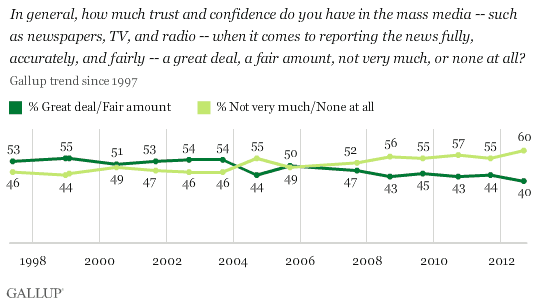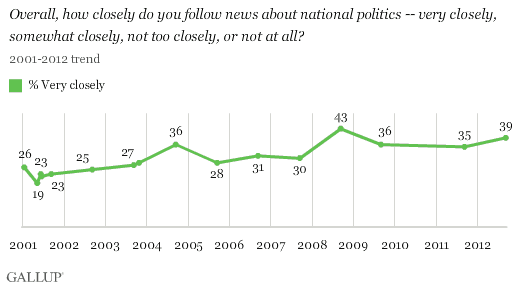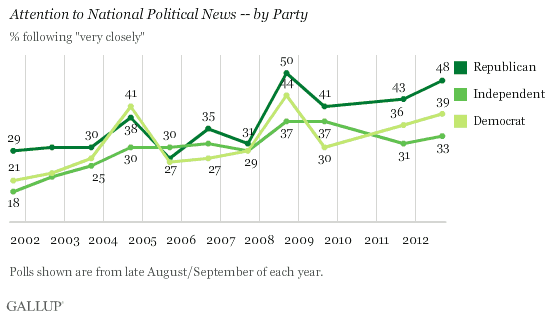WASHINGTON, D.C. -- Americans' distrust in the media hit a new high this year, with 60% saying they have little or no trust in the mass media to report the news fully, accurately, and fairly. Distrust is up from the past few years, when Americans were already more negative about the media than they had been in years prior to 2004.

The record distrust in the media, based on a survey conducted Sept. 6-9, 2012, also means that negativity toward the media is at an all-time high for a presidential election year. This reflects the continuation of a pattern in which negativity increases every election year compared with the year prior. The current gap between negative and positive views -- 20 percentage points -- is by far the highest Gallup has recorded since it began regularly asking the question in the 1990s. Trust in the media was much higher, and more positive than negative, in the years prior to 2004 -- as high as 72% when Gallup asked this question three times in the 1970s.
This year's decline in media trust is driven by independents and Republicans. The 31% and 26%, respectively, who express a great deal or fair amount of trust are record lows and are down significantly from last year. Republicans' level of trust this year is similar to what they expressed in the fall of 2008, implying that they are especially critical of election coverage.
Independents are sharply more negative compared with 2008, suggesting the group that is most closely divided between President Barack Obama and Republican Mitt Romney is quite dissatisfied with its ability to get fair and accurate news coverage of this election.
More broadly, Republicans continue to express the least trust in the media, while Democrats express the most. Independents' trust fell below the majority level in 2004 and has continued to steadily decline.

Attention Paid to Political News Lower Than in 2008
Americans tend to pay more attention to political news in presidential election years, and that is the case in 2012. However, Americans are less likely this year to be paying close attention to news about national politics than they were in 2008. The 39% who say they are paying close attention is up from last year -- when Americans were paying a high level of attention compared with other non-election years -- but down from 43% in September 2008.

Despite their record-low trust in media, Republicans are the partisan group most likely to be paying close attention to news about national politics, with the 48% who are doing so similar to the 50% in 2008 and up significantly from 38% in 2004. Independents and Democrats are less likely than Republicans to be paying close attention, with their levels of attention similar to 2008 and 2004.

Implications
Americans are clearly down on the news media this election year, with a record-high six in 10 expressing little or no trust in the mass media's ability to report the news fully, accurately, and fairly. This likely reflects the continuation of the trend seen in recent years, combined with the increased negativity toward the media that election years tend to bring. This is particularly consequential at a time when Americans need to rely on the media to learn about the platforms and perspectives of the two candidates vying to lead the country for the next four years.
The lower level of interest in news about national politics during this election year may also reflect the level of interest in the presidential election specifically. This survey was conducted immediately after the conclusion of both political conventions and thus may indicate the level of attention paid to those events in particular. Since this survey was conducted, Democrats' enthusiasm about voting has swelled nationally and in swing states.
On a broad level, Americans' high level of distrust in the media poses a challenge to democracy and to creating a fully engaged citizenry. Media sources must clearly do more to earn the trust of Americans, the majority of whom see the media as biased one way or the other. At the same time, there is an opportunity for others outside the "mass media" to serve as information sources that Americans do trust.
Survey Methods
Results are based on telephone interviews conducted Sept. 6-9, 2012, with a random sample of 1,017 adults, aged 18 and older, living in all 50 U.S. states and the District of Columbia.
For results based on the total sample of national adults, one can say with 95% confidence that the margin of error is ±4 percentage points.
Interviews are conducted with respondents on landline telephones and cellular phones, with interviews conducted in Spanish for respondents who are primarily Spanish-speaking. Each sample includes a minimum quota of 400 cell phone respondents and 600 landline respondents per 1,000 national adults, with additional minimum quotas among landline respondents by region. Landline telephone numbers are chosen at random among listed telephone numbers. Cell phone numbers are selected using random-digit-dial methods. Landline respondents are chosen at random within each household on the basis of which member had the most recent birthday.
Samples are weighted by gender, age, race, Hispanic ethnicity, education, region, adults in the household, and phone status (cell phone only/landline only/both, cell phone mostly, and having an unlisted landline number). Demographic weighting targets are based on the March 2011 Current Population Survey figures for the aged 18 and older non-institutionalized population living in U.S. telephone households. All reported margins of sampling error include the computed design effects for weighting and sample design.
In addition to sampling error, question wording and practical difficulties in conducting surveys can introduce error or bias into the findings of public opinion polls.
View methodology, full question results, and trend data.
For more details on Gallup's polling methodology, visit www.gallup.com.
